Stone-coated steel roof tiles, also known as metal roof shingles or stone-coated steel roofing, represent a modern and robust roofing option. Crafted from premium galvanized steel and coated with a layer of stone granules, these tiles offer an attractive appearance reminiscent of traditional clay, slate, or asphalt shingles.
Advantages of Stone-Coated Roof Tiles:
1. Durability: Withstands severe weather conditions, including rain, wind, and hail.
2. Fire Resistance: Non-combustible, ideal for regions prone to wildfires.
3. Energy Efficiency: Reflective qualities reduce heat absorption, leading to energy savings.
4. Low Maintenance: Resistant to cracking, fading, and insect damage.
5. Aesthetics: Available in a wide array of colors and designs.
6. Eco-Friendly: Recyclable and can be installed over existing roofs, reducing waste.
7. Easy Installation: Lightweight, which lowers costs and eases structural demands.
8. Long-Term Value: A stylish and energy-efficient roofing option for the ages.
How to Manufacture Stone-Coated Steel Roofing Tiles:

The production of stone-coated steel roofing tiles involves a meticulous process to ensure longevity, weather resistance, and visual appeal. Here’s an overview of the manufacturing steps:
1. Steel Base Preparation
Material Selection: Select high-grade, galvanized steel sheets to serve as the base, with a protective zinc layer to prevent rust and corrosion.
Cutting: Use precision equipment to cut the steel sheets into the required sizes and shapes for the tiles.
2. Adhesive Application
Adhesive Coating: Apply a layer of adhesive to the steel tile surface to bond with the stone granules in the subsequent step.
3. Stone Granule Application
Granule Layering: Scatter stone granules over the adhesive-covered steel tiles, enhancing their appearance and resilience.
Curing: Allow the tiles to cure, ensuring the granules are firmly attached to the adhesive.
4. Acrylic Coating Application
Sealing Coating: Apply an acrylic coating over the stone granules to secure them and provide additional environmental protection.
Drying: Thoroughly dry the acrylic coating, often involving passage through a heated drying tunnel.
5. Quality Control
Inspection: Conduct a thorough check for defects such as missing granules, inconsistent coating, or damage to ensure only top-quality tiles are packaged and distributed.
Packaging: Once they pass inspection, the tiles are prepared for shipping or storage.
6. Optional Steps
Color Coating: Some manufacturers may apply a colored coating over the acrylic for specific color effects.
Customization: Tiles can be tailored to various shapes, sizes, and finishes based on manufacturer and customer preferences.
7. Storage and Handling
Storage: Keep the finished tiles in a dry, sheltered area to prevent damage before installation.
Handling: Handle the tiles carefully during the installation process to prevent damage to the stone granules.
The manufacturing process of stone-coated steel roofing tiles is crafted to yield a product that is resilient, enduring, and capable of withstanding a range of environmental challenges. The end result should be a tile that is simple to install and requires minimal upkeep over its lifetime.
